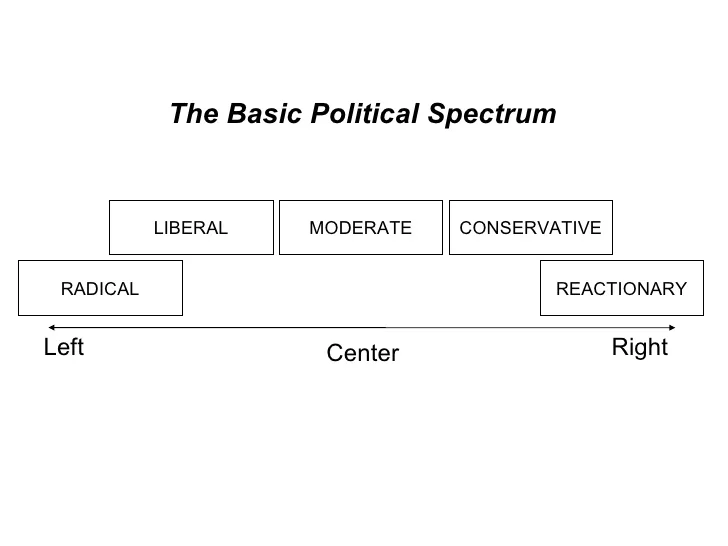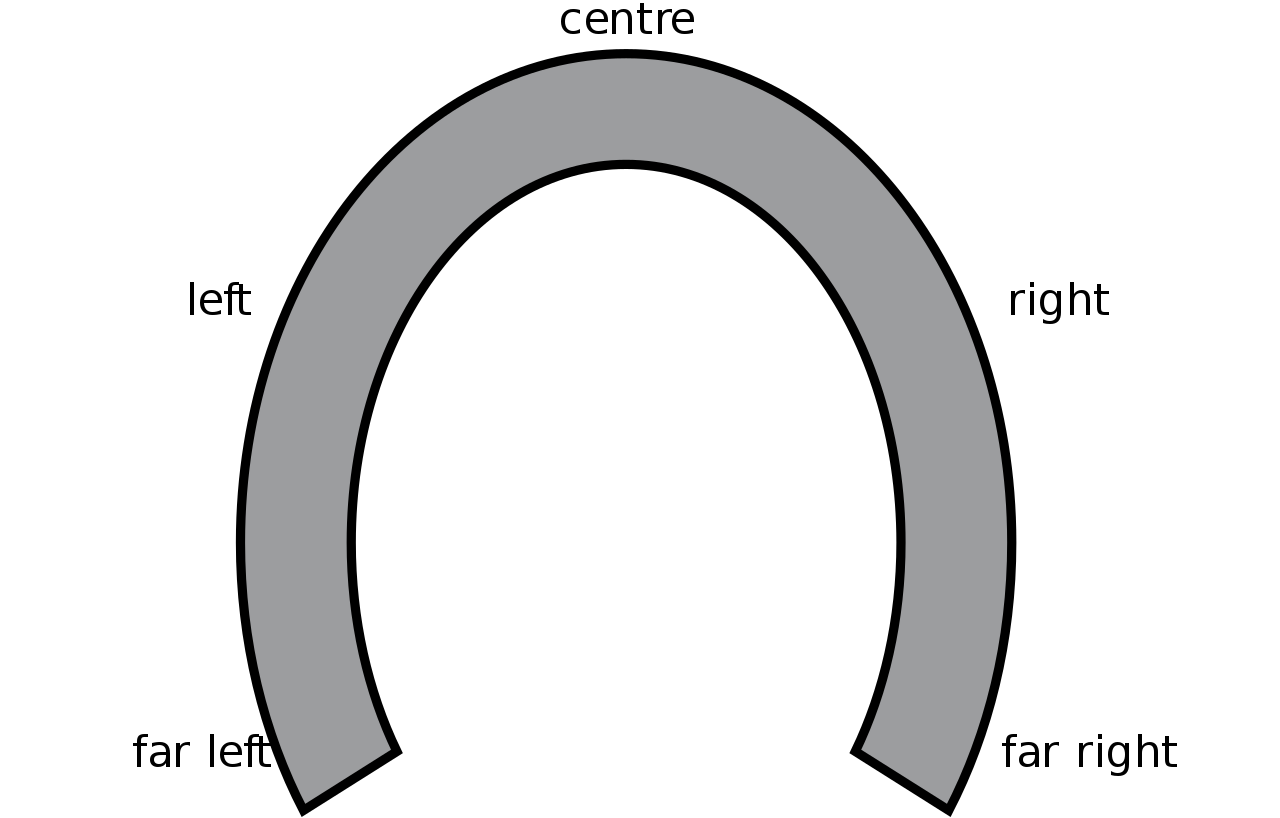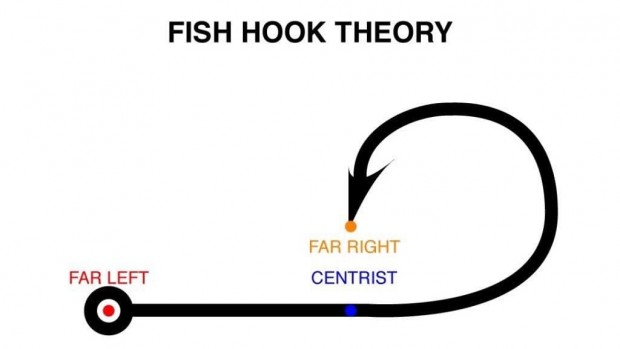Left–right political spectrum: Difference between revisions
More languages
More actions
m (The lower-case letter "L" was not bolded for some reason) |
General-KJ (talk | contribs) m (→Left wing: Corrected Typo) Tag: Visual edit |
||
| (5 intermediate revisions by 3 users not shown) | |||
| Line 1: | Line 1: | ||
The '''left–right political spectrum''' is a diagram intended to | [[File:Political spectrum.png|thumb|Basic one-dimensional political spectrum]] | ||
The '''left–right political spectrum''' is a diagram intended to categorize political ideologies in 3 distinct categories: [[Left-wing politics|left wing]], [[Right-wing politics|right wing]] and [[Centrism|centrist]]. The model has received criticism for being [[Idealism|idealist]], unscientific, subjective, and for ignoring [[historical materialism]] and [[class struggle]].{{Citation needed}} | |||
There are successors or variations to the | There are successors or variations to the left-right spectrum, one of the most famous successors being the two-dimensional [[Political Compass|political compass]]. Variations of the one-dimensional spectrum include the horseshoe theory and the fish hook theory. | ||
==History== | |||
The methodology is derived from the time of the [[French Revolution|French Revolution of 1789]], when the newly formed National Constituent Assembly had been divided from left to right over time. The people in [[Republicanism|opposition]] to the [[Monarchism|monarchy]] sitting to the left and the monarchists sitting to the right. This evolved with the establishment and replacement of the National Assembly with the Legislative assembly in 1791. With new members and principles, however, the fundamental seating of ideological motives was maintained with the so-called “innovators” on the left, the “moderates” in the middle, and the “conservatives” on the right.{{Citation needed}} | |||
==Description == | |||
== Description == | |||
The model is split into 3 categories (sometimes 2), the left wing, the right wing and the centrists. There can be also prefixes adjoined to the parts of the spectrum as 'far-left' or 'center-right' (not to be confused with centrist), which specify the location within the political spectrum. It is a visible one dimensional line going from left to right. | The model is split into 3 categories (sometimes 2), the left wing, the right wing and the centrists. There can be also prefixes adjoined to the parts of the spectrum as 'far-left' or 'center-right' (not to be confused with centrist), which specify the location within the political spectrum. It is a visible one dimensional line going from left to right. | ||
=== Left wing === | ===Left wing=== | ||
The left wing broadly describes the [[Progressivism|progressives]] in a given society, from [[Marxism–Leninism|Marxism-Leninism]] to [[social democracy]], or the support of specific policies such as the support of [[LGBT+|LGBT]] rights in the [[United States of America|USA]].{{Citation needed}} | |||
=== | ===Right wing=== | ||
The | The right wing describes as those who oppose progress or actively support [[Reactionary|reaction]]. It may refer to several political ideologies, extending from [[libertarianism]] to [[fascism]].{{Citation needed}} | ||
=== | ===Centrist=== | ||
No to be confused with apolitical and moderate, centrists are typically people who support (and somewhat oppose) both stances, sometimes rejecting one idea of the part over another or choosing neither. In practice, they uphold the [[Imperialism|status quo]] and thereby overlap with the right wing.{{Citation needed}} | |||
== | ==Variations == | ||
===Horseshoe theory === | |||
[[File:Horseshoe theory.png|thumb]] | |||
The horseshoe theory is an adaptation of the left-right spectrum, where the furthest left and the furthest right points are brought closer together in the form of a 'horseshoe' shape, to state that the far-left is similar or identical to the [[Far-right politics|far-right]] but both are different from [[Liberalism|liberals]].<ref name=":0">{{Web citation|author=Rachel Nagant|newspaper=[[Red Clarion]]|title=Debunking 10 Common Misconceptions of Communism|date=2023-07-05|url=https://clarion.unity-struggle-unity.org/10-misconceptions-of-communism/|archive-url=https://web.archive.org/web/20230708182606/https://clarion.unity-struggle-unity.org/10-misconceptions-of-communism/|archive-date=2023-07-08}}</ref> This is despite the fact that historical materialism refutes this, as the far-left are [[Anti-fascism|anti-fascist]] and [[Second World War|fought]] countries such as [[German Reich (1933–1945)|Nazi Germany]]. | |||
=== | ===Fish hook theory === | ||
[[File:Fish hook theory.png|thumb]] | |||
The fish hook theory is an adaptation of the left-right spectrum where the far-right is curved towards the center, in the shape of a 'hook', to state that old sayings such as 'Scratch a liberal, a fascist bleeds'. This view is more accurate but still falls apart due to its subjectivity and unscientific nature.{{Citation needed}} | |||
In the | ==Criticism == | ||
===Subjective === | |||
The left-right spectrum changes varies based on region. In the United States, [[Social democracy|social democrats]] are considered 'far-left' and Liberals are considered 'Left-Wing' whilst Conservatives are considered 'Center-Right'. | |||
=== Unscientific === | In the case of the [[UK]] for example, Liberals are considered 'Center-Right', and Social Democracies are considered 'center-left' whilst socialists are considered 'far-left'.{{Citation needed}} | ||
The | ===Unscientific === | ||
The political spectrum attempts to place different [[Mode of production|modes of production]] on a single scale even though they are qualitatively different. It defines ideologies based on a numerical difference in the size or power of the [[state]], which may be useful for comparing different forms of [[capitalism]] such as [[neoliberalism]] and [[John Maynard Keynes|Keynesianism]] but cannot accurately portray the differences between [[socialism]] and capitalism or capitalism and [[feudalism]].<ref name=":0" /> | |||
== | == References == | ||
[[Category:Pages needing references]] | |||
[[Category:Politics]] | |||
Latest revision as of 09:59, 11 March 2024

The left–right political spectrum is a diagram intended to categorize political ideologies in 3 distinct categories: left wing, right wing and centrist. The model has received criticism for being idealist, unscientific, subjective, and for ignoring historical materialism and class struggle.[citation needed]
There are successors or variations to the left-right spectrum, one of the most famous successors being the two-dimensional political compass. Variations of the one-dimensional spectrum include the horseshoe theory and the fish hook theory.
History[edit | edit source]
The methodology is derived from the time of the French Revolution of 1789, when the newly formed National Constituent Assembly had been divided from left to right over time. The people in opposition to the monarchy sitting to the left and the monarchists sitting to the right. This evolved with the establishment and replacement of the National Assembly with the Legislative assembly in 1791. With new members and principles, however, the fundamental seating of ideological motives was maintained with the so-called “innovators” on the left, the “moderates” in the middle, and the “conservatives” on the right.[citation needed]
Description[edit | edit source]
The model is split into 3 categories (sometimes 2), the left wing, the right wing and the centrists. There can be also prefixes adjoined to the parts of the spectrum as 'far-left' or 'center-right' (not to be confused with centrist), which specify the location within the political spectrum. It is a visible one dimensional line going from left to right.
Left wing[edit | edit source]
The left wing broadly describes the progressives in a given society, from Marxism-Leninism to social democracy, or the support of specific policies such as the support of LGBT rights in the USA.[citation needed]
Right wing[edit | edit source]
The right wing describes as those who oppose progress or actively support reaction. It may refer to several political ideologies, extending from libertarianism to fascism.[citation needed]
Centrist[edit | edit source]
No to be confused with apolitical and moderate, centrists are typically people who support (and somewhat oppose) both stances, sometimes rejecting one idea of the part over another or choosing neither. In practice, they uphold the status quo and thereby overlap with the right wing.[citation needed]
Variations[edit | edit source]
Horseshoe theory[edit | edit source]

The horseshoe theory is an adaptation of the left-right spectrum, where the furthest left and the furthest right points are brought closer together in the form of a 'horseshoe' shape, to state that the far-left is similar or identical to the far-right but both are different from liberals.[1] This is despite the fact that historical materialism refutes this, as the far-left are anti-fascist and fought countries such as Nazi Germany.
Fish hook theory[edit | edit source]

The fish hook theory is an adaptation of the left-right spectrum where the far-right is curved towards the center, in the shape of a 'hook', to state that old sayings such as 'Scratch a liberal, a fascist bleeds'. This view is more accurate but still falls apart due to its subjectivity and unscientific nature.[citation needed]
Criticism[edit | edit source]
Subjective[edit | edit source]
The left-right spectrum changes varies based on region. In the United States, social democrats are considered 'far-left' and Liberals are considered 'Left-Wing' whilst Conservatives are considered 'Center-Right'.
In the case of the UK for example, Liberals are considered 'Center-Right', and Social Democracies are considered 'center-left' whilst socialists are considered 'far-left'.[citation needed]
Unscientific[edit | edit source]
The political spectrum attempts to place different modes of production on a single scale even though they are qualitatively different. It defines ideologies based on a numerical difference in the size or power of the state, which may be useful for comparing different forms of capitalism such as neoliberalism and Keynesianism but cannot accurately portray the differences between socialism and capitalism or capitalism and feudalism.[1]
References[edit | edit source]
- ↑ 1.0 1.1 Rachel Nagant (2023-07-05). "Debunking 10 Common Misconceptions of Communism" Red Clarion. Archived from the original on 2023-07-08.
